Benign Prostatic Hyperplasia is a non‑cancerous enlargement of the prostate gland that affects about 50% of men by age 60 and nearly 90% by age 85. This growth squeezes the urethra, often leading to a cluster of complaints called Lower Urinary Tract Symptoms (LUTS). Understanding the connection helps men and clinicians act before the discomfort turns into chronic urinary trouble.
TL;DR
- BPH is the main driver of LUTS in men over 40.
- Symptoms arise from bladder outlet obstruction and altered bladder muscle activity.
- Diagnosis combines symptom scores, physical exam, and simple flow tests.
- Medication categories-alpha‑blockers and 5‑α‑reductase inhibitors-target different disease steps.
- Lifestyle tweaks (fluid timing, caffeine reduction, pelvic‑floor exercises) can halve symptom severity.
Why BPH Produces Urinary Symptoms
The prostate sits just below the bladder, wrapping the urethra. As prostate gland tissue multiplies, two physical forces appear:
- Static compression: The enlarged gland narrows the urethral lumen, creating a constant resistance to urine flow.
- Dynamic tone: Smooth‑muscle fibers in the prostate tighten under hormonal influence, adding a reversible constriction.
The bladder reacts in two ways. First, it contracts harder to overcome resistance, which feels like urgency or a sudden need to rush. Second, chronic overload makes the bladder wall stiff, causing incomplete emptying and nocturnal trips to the bathroom (nocturia).
Key Players in the BPH‑LUTS Chain
To see the full picture, think of the urinary system as a team of organs and tests that communicate constantly. Below are the most relevant entities, each introduced with core attributes:
- Lower Urinary Tract Symptoms - grouped into storage (frequency, urgency, nocturia) and voiding (weak stream, straining, incomplete emptying) categories.
- urinary bladder - a muscular reservoir that must contract efficiently; its compliance drops when exposed to high outlet pressure.
- uroflowmetry - an office test measuring peak flow rate (Qmax) and voided volume; a Qmax<15mL/s often signals obstruction.
- alpha‑blockers - drugs (e.g., tamsulosin) that relax prostate smooth muscle, lowering dynamic tone within hours.
- 5‑alpha‑reductase inhibitors - agents (e.g., finasteride) that shrink gland size by blocking DHT conversion, showing effects after months.
- lifestyle modifications - fluid timing, caffeine/alcohol reduction, and pelvic‑floor training that improve storage symptoms without medication.
- prostate‑specific antigen (PSA) - a blood marker that rises modestly with BPH; useful to rule out cancer when combined with digital exam.
How Doctors Confirm the BPH‑LUTS Link
Diagnosis follows a step‑wise algorithm that blends symptom scoring with objective measures:
- International Prostate Symptom Score (IPSS): A questionnaire (0‑35) that grades severity; scores>19 indicate severe LUTS.
- Digital Rectal Examination (DRE): Allows the clinician to feel gland size and consistency.
- Serum PSA: Levels <4ng/mL are typical for BPH; higher values trigger further cancer work‑up.
- Uroflowmetry: Captures peak flow (Qmax) and post‑void residual (PVR). A PVR>100mL often points to bladder outlet obstruction.
- Transrectal Ultrasound (TRUS) or MRI (optional): Provides precise volume; BPH usually exceeds 30mL.
When two or more objective findings line up with a high IPSS, the BPH‑LUTS connection is considered confirmed, and treatment planning begins.
Choosing the Right Treatment Path
Therapy balances speed of relief, side‑effect profile, and long‑term disease control. Below is a side‑by‑side snapshot of the two main drug families.
| Attribute | Alpha‑Blockers | 5‑Alpha‑Reductase Inhibitors |
|---|---|---|
| Primary Mechanism | Relax smooth‑muscle tone in prostate and bladder neck | Block conversion of testosterone to dihydrotestosterone (DHT) |
| Onset of Symptom Relief | Hours to days | 3‑6months |
| Typical Effect on Prostate Size | None | 20‑30% reduction |
| Common Side Effects | Dizziness, ejaculatory dysfunction | Sexual dysfunction, breast tenderness |
| Best for | Men with moderate‑to‑severe LUTS needing rapid relief | Men with large prostate volumes (>40mL) and progressive symptoms |
In practice, many urologists start with an alpha‑blocker for immediate comfort and add a 5‑α‑reductase inhibitor later if the gland remains large. Combination therapy (e.g., tamsulosin+finasteride) has been shown in large trials to cut surgery rates by up to 30%.

Non‑Pharmacologic Strategies That Work
Medication isn’t the only answer. Simple habit tweaks often cut symptom scores in half:
- Fluid timing: Limit intake two hours before bedtime to reduce nocturia.
- Caffeine/alcohol cut‑back: Both act as diuretics and can worsen urgency.
- Pelvic‑floor (Kegel) exercises: Strengthen the sphincter, improve voiding efficiency.
- Weight management: Obesity raises intra‑abdominal pressure, aggravating bladder outlet obstruction.
These steps are especially valuable for men who cannot tolerate alpha‑blockers due to low blood pressure.
When Surgery Becomes Necessary
About 10‑15% of men with BPH eventually need a procedure. Indications include:
- Recurrent urinary retention.
- Severe LUTS unresponsive to optimal medical therapy.
- Complications such as bladder stones or kidney damage.
Modern minimally invasive options-like laser enucleation (HoLEP) or water‑jet ablation (Aquablation)-offer shorter hospital stays and lower bleeding risk compared with the classic transurethral resection of the prostate (TURP). Choice depends on prostate size, surgeon expertise, and patient comorbidities.
Connecting the Dots: A Real‑World Example
John, 68, visited his urologist complaining of waking up three times nightly to urinate and a weak stream that forced him to linger at the sink. His IPSS was 23, DRE showed a 45‑mL gland, and uroflowmetry recorded a Qmax of 11mL/s. The physician started tamsulosin 0.4mg daily and advised John to cut caffeine after noon. Within two weeks, his nocturia dropped to once per night, and his IPSS fell to 15. Six months later, finasteride was added because follow‑up ultrasound still showed a 44‑mL prostate. At the one‑year mark, the gland had shrunk to 35mL, John’s IPSS was 8, and he reported no further nighttime trips.
John’s story illustrates the stepwise, evidence‑based approach: symptom scoring ➜ objective testing ➜ targeted medication ➜ lifestyle tweaks ➜ long‑term gland shrinkage.
Key Takeaways
- BPH is the leading cause of lower urinary tract symptoms in men over 40.
- Static obstruction and dynamic muscle tone together drive storage and voiding complaints.
- Diagnosis combines patient‑reported scores, physical exam, PSA, and simple flow tests.
- Alpha‑blockers give quick relief; 5‑α‑reductase inhibitors provide lasting size reduction.
- Lifestyle changes can dramatically improve quality of life and even reduce medication needs.
- Surgery is reserved for persistent or complicated cases, with several minimally invasive options now available.
Frequently Asked Questions
What is the difference between storage and voiding LUTS?
Storage symptoms involve how the bladder holds urine (frequency, urgency, nocturia). Voiding symptoms describe how urine exits the body (weak stream, straining, incomplete emptying). Both groups often appear together in BPH because the prostate blocks flow and forces the bladder to work harder.
Can BPH lead to kidney damage?
Yes, if the outlet obstruction is severe and persistent, urinary back‑pressure can travel up to the kidneys, causing hydronephrosis and reduced renal function. Early detection with post‑void residual measurements helps prevent this complication.
How long does it take for a 5‑alpha‑reductase inhibitor to shrink the prostate?
Most men see a measurable volume drop after 3‑6months, with an average 20‑30% reduction after a year of consistent dosing.
Are there any natural supplements that help with BPH?
Saw palmetto, beta‑sitosterol, and pygeum have modest evidence for symptom relief, but they work best as adjuncts to proven medical therapy. Always discuss supplements with a urologist to avoid interactions.
When should I consider surgical treatment for BPH?
If you experience recurrent urinary retention, persistent severe LUTS despite optimized medication, or complications like bladder stones, a urologist will discuss minimally invasive surgery options.
Does an enlarged prostate increase the risk of prostate cancer?
BPH itself does not cause cancer, but because both conditions are age‑related, men with BPH should still undergo routine PSA testing and digital exams to rule out malignancy.
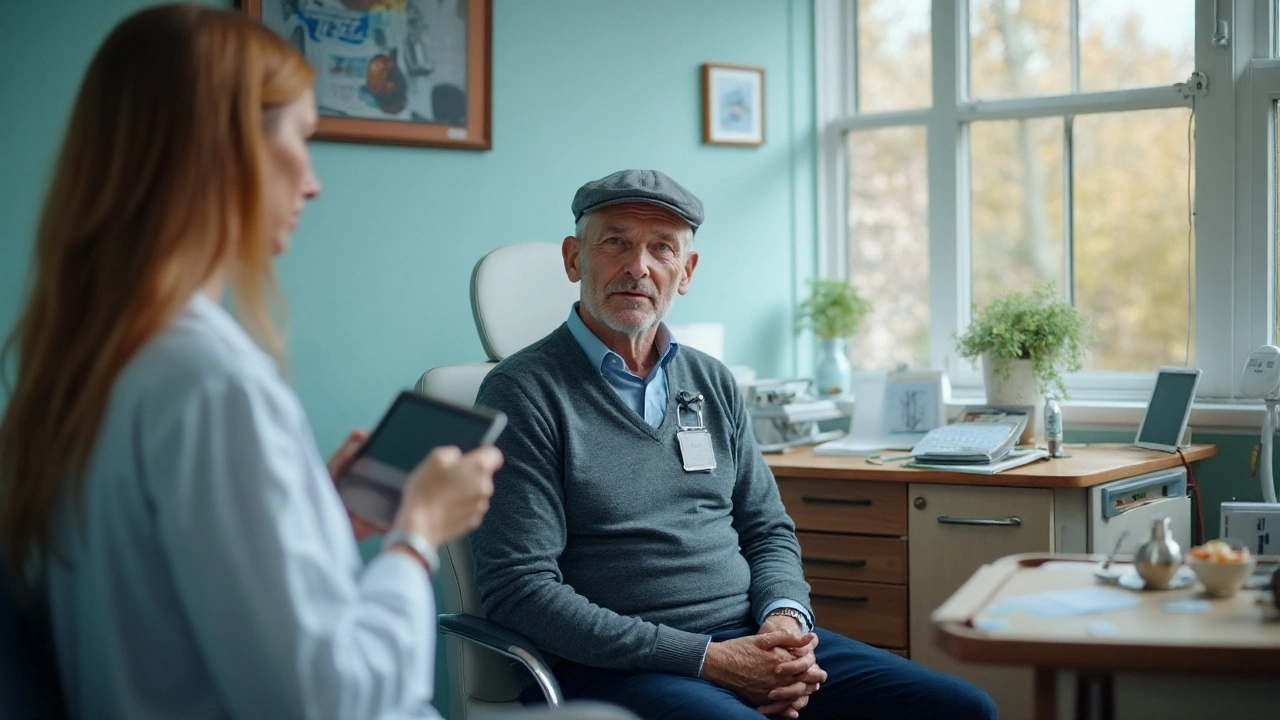
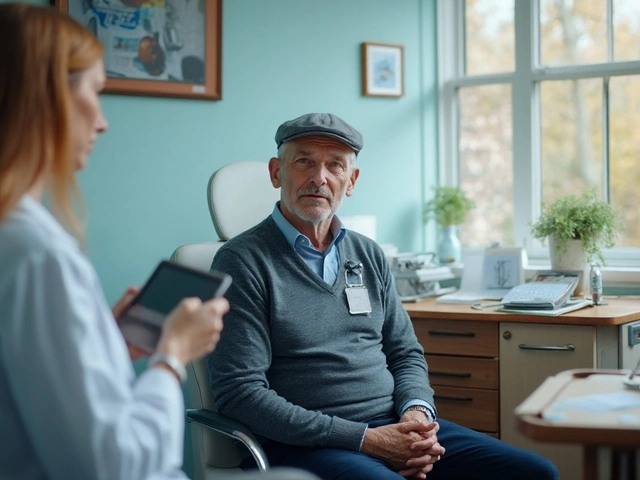
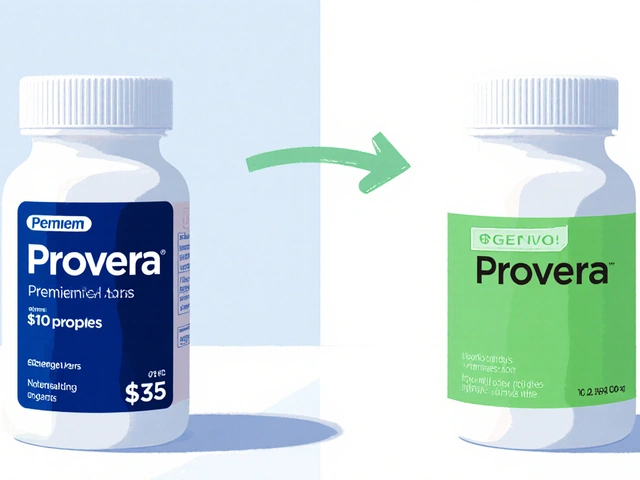
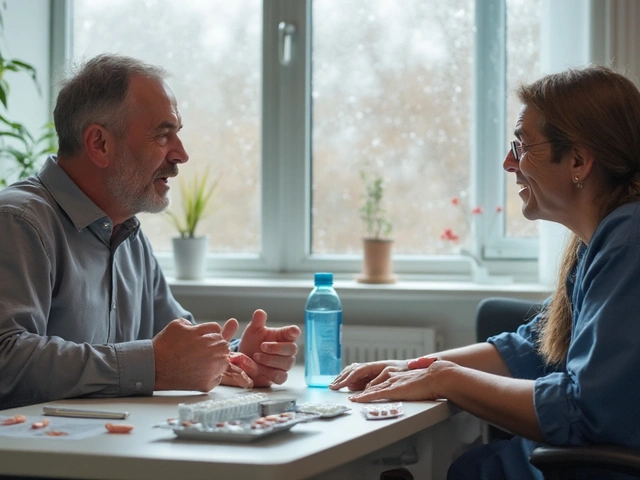
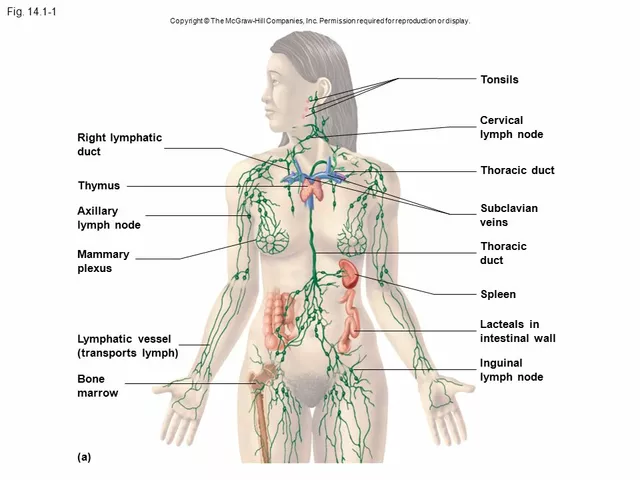



Nolan Jones September 24, 2025
Yo, BPH’s basically the prostate’s way of saying it’s got too many fans – it swells and messes with your flow. The good news is alpha‑blockers can chill the muscle tone fast, while 5‑α‑reductase inhibitors shrink the gland over months. Cutting caffeine after lunch and doing Kegels overnight can cut nocturia in half. If you’re feeling dizzy on tamsulosin, talk to your doc about dose tweaks. Stay hydrated but not right before bed – trust me, your bladder will thank you. Also, a quick check‑up with your urolgy specialist can rule out other issues.
Jada Singleton October 3, 2025
The article glosses over the nuanced pathophysiology of LUTS, reducing a complex neuro‑urological cascade to “static compression” and “dynamic tone.” While the tables are accurate, the narrative fails to address the role of autonomic dysregulation and its impact on bladder compliance. Moreover, the recommendation to start alpha‑blockers indiscriminately ignores the substantial evidence of adverse cardiovascular events in hypertensive patients. A more critical appraisal would have highlighted patient‑specific risk stratification rather than a one‑size‑fits‑all algorithm.
Emily Rossiter October 12, 2025
Reading the breakdown, it’s clear that you don’t have to feel trapped by BPH – there are many levers you can pull to regain comfort. First, remember that symptom scores like the IPSS are not just numbers; they reflect real quality‑of‑life changes that deserve attention. Second, the combination therapy mentioned works because it attacks both the muscle tone and the gland size, giving you faster relief and longer‑term shrinkage. Third, lifestyle tweaks such as limiting evening fluids and cutting caffeine are simple, low‑cost interventions that often halve nocturnal trips. Fourth, pelvic‑floor exercises may feel odd at first, but they strengthen the sphincter and improve emptying efficiency over weeks. Fifth, weight management can reduce intra‑abdominal pressure, which in turn eases bladder outlet obstruction. Sixth, regular follow‑up uroflowmetry lets you track objective improvement beyond subjective feelings. Seventh, PSA testing remains essential not because it treats BPH, but because it screens for malignancy that can masquerade as LUTS. Eighth, if side effects from alpha‑blockers become problematic, discussing a dose reduction or alternate agent with your urologist is prudent. Ninth, the delayed action of 5‑α‑reductase inhibitors should be set as an expectation – they are not miracle pills but steady reducers of prostate volume. Tenth, many men find that a staggered approach – starting with an alpha‑blocker for immediate relief, then adding a reductase inhibitor later – matches their symptom trajectory. Eleventh, the newer minimally invasive surgeries like HoLEP have lower bleeding risk and quicker recovery compared with traditional TURP, expanding options for those who need procedural intervention. Twelfth, remember that mental health matters; the anxiety of frequent nighttime bathroom trips can be mitigated with relaxation techniques before bed. Thirteenth, staying informed and actively participating in decision‑making improves adherence and outcomes. Fourteenth, each of these steps can be tailored to your personal health profile, making the management plan truly individualized. Finally, never hesitate to ask your doctor for clarification – a clear understanding empowers you to manage BPH proactively.
Renee van Baar October 22, 2025
Understanding BPH is a team effort – your doctor, you, and the data all play roles. While the static compression concept is easy to grasp, the dynamic smooth‑muscle tone adds a layer of complexity that many patients overlook; this reversible component is why alpha‑blockers can provide rapid symptom relief without shrinking the gland. It’s also worth noting that bladder compliance can deteriorate over years of obstruction, making early intervention crucial to preserve long‑term function. Lifestyle modifications, such as fluid timing and pelvic‑floor strengthening, are not merely adjuncts but foundational pillars that can halve symptom severity when applied consistently. In short: address the obstruction, manage the muscle tone, and support the bladder with healthy habits.
Mithun Paul October 31, 2025
Whilst the author’s exposition is comprehensive, the reliance on pharmaceutical monotherapy betrays a myopic allegiance to industry‑driven paradigms. A rigorous, evidence‑based protocol would prioritize non‑pharmacological interventions as first‑line therapy, reserving alpha‑blockers and 5‑α‑reductase inhibitors for cases unequivocally refractory to lifestyle modification. Moreover, the omission of cost‑effectiveness analyses undermines the applicability of the recommendations within resource‑constrained settings, where the financial burden of combination therapy may be prohibitive. It is incumbent upon clinicians to scrutinize the therapeutic hierarchy presented and to adopt a more judicious, patient‑centred approach.
Sandy Martin November 9, 2025
I totally get how frustating those nightly bathroom trips can be, especially when you’re trying to get some solid sleep. It’s amazing how something as simple as cutting that late‑night coffee can make a real difference. And don’t worry if the meds make you feel a bit off at first – many folks experience mild dizziness that settles after a week or two. Keep an eye on your flow numbers and let your doc know if anything feels off, okay?
Steve Smilie November 18, 2025
Ah, the symphony of prostatic hypertrophy! One must appreciate the intricate ballet between androgenic signaling and stromal proliferation, a veritable theatrical performance within the pelvis. When the curtain rises on nocturia, it is not merely a nuisance but a herald of the gland’s overambitious crescendo. Therefore, the clinician ought to don a mantle of both scientist and poet, prescribing with the finesse of a maestro and the precision of a virtuoso. Let us not reduce this marvel to mere tables, but celebrate its complexity with the reverence it deserves.
Josie McManus November 28, 2025
Look, you don’t have to just sit there and suffer – take charge of your bladder health now. Cut the caffeine, do those Kegels, and talk to your doctor about trying an alpha‑blocker if you need quick relief. No excuses, just action.
Heather Kennedy December 7, 2025
The therapeutic algorithm for BPH‑LUTS should be conceptualized within a stepwise framework, integrating both pharmacodynamic considerations (α‑adrenergic antagonism vs. 5‑α‑reductase inhibition) and patient‑centric outcomes such as IPSS trajectory and post‑void residual volume. Moreover, adjunctive modalities like behavioral fluid management and pelvic‑floor biofeedback constitute essential components of a multimodal regimen, optimizing both storage and voiding domains. In practice, aligning these interventions with evidence‑based guidelines enhances efficacy while minimizing iatrogenic adverse events.